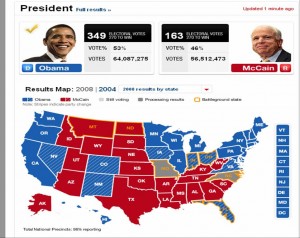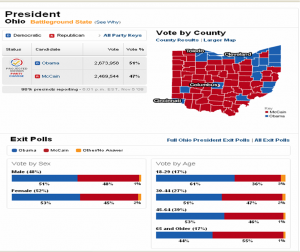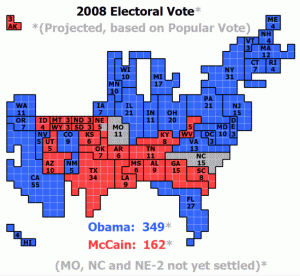Andrew Marr takes to the skies exploring Britain from above.
An epic journey revealing the secrets, patterns and hidden rhythms of our lives from a striking new perspective.
Join host Andrew Marr as he discovers how each and every one of us is interconnecting making Britain what it is today.
Britain looks very different from the skies. From a bird’s eye view of the nation, its workings, cities, landscapes and peoples are revealed and re-discovered in new and extraordinary ways. [more…]
You are currently browsing the monthly archive for November 2008.
This paper includes an awesome table (p.003) which outlines attributes related to research data sharing in academic health centres. The table includes determinants of data access from the perspective of data storage, controls on access to data, and who determines access permissions.
The paper also includes 7 recommendations for Academic Health Centres (AHC) to encourage data sharing which I think can be modified to suit other contexts:
- Commit to sharing data as openly as possible, given privacy constraints. Streamline institutional review boards, technology transfer, and information technology policies and procedures accordingly.
- Recognize data sharing contributions in hiring and promotion decisions, perhaps as a bonus to a publication’s impact factor. Use concrete metrics when available. [I like that they understand the incentive structures of this group]
- Educate trainees and current investigators on responsible data sharing and reuse practices through class work, mentorship, and professional development. Promote a framework for deciding upon appropriate data sharing mechanisms.
- Encourage data sharing practices as part of publication policies. Lobby for explicit and enforceable policies in journal and conference instructions, to both authors and peer reviewers.
- Encourage data sharing plans as part of funding policies. Lobby for appropriate data sharing requirements by funders, and recommend that they assess a proposal’s data sharing plans as part of its scientific contributions.
- Fund the cost of data sharing, support for repositories, adoption of sharing infrastructure and metrics, and research into best practices through federal grants and AHC funds.
- Publish experiences in data sharing to facilitate the exchange of best practices.
I have not looked at this literature in a while, but my sense is the discourse is moving away from problems to providing solutions. Most importantly in the case of this paper, they are culture shifting since, in a sense they a pushing toward an open access ideology by creating an environment conducive to sharing by hiring the right people, providing the appropriate incentives, marketing successes, changing publication practices, educating and promoting open access within. This is most interesting as this is the medical profession, a bastion of commerce and privacy concerns that is moving to open access faster than our Statistical Agency in Canada!
The full paper is available for free in myriad formats!
Piwowar HA, Becich MJ, Bilofsky H, Crowley RS, on behalf of the caBIG Data Sharing and Intellectual Capital Workspace (2008), Towards a Data Sharing Culture: Recommendations for Leadership from Academic Health Centers. PLoS Med 5(9): e183
The publisher, PLoS Medicine:
PLoS Medicine believes that medical research is an international public resource. The journal provides an open-access venue for important, peer-reviewed advances in all disciplines. With the ultimate aim of improving human health, we encourage research and comment that address the global burden of disease.
PLoS Medicine (eISSN 1549-1676; ISSN-1549-1277) is an open-access, peer-reviewed medical journal published monthly online by the Public Library of Science (PLoS), a nonprofit organization. The inaugural issue was published on 19 October 2004.
November issue of Genome Technology focuses entirely on Open Access openly available under a CC license. The articles discussed both data and publications. Wonderful! See page 40 of the journal to read Ready or Not, Here Comes Open Access.
Via: SPARC, the Scholarly Publishing and Academic Resources Coalition
Tags: Add new tag
Wi-fi structures and people shapes, from Dan Hill:
One of the ideas I’ve been exploring relates to how urban industry – in the widest sense of the word – in the knowledge economy is often invisible, at least immediately and in situ. Whereas urban industry would once have produced thick plumes of smoke or deafening sheets of sound, today’s information-rich environments – like the State Library of Queensland, or a contemporary office – are places of still, quiet production, with few sensory side-effects. We see people everywhere, faces lit by their open laptops, yet no evidence of their production. They could be using Facebook, Photoshop, Excel or Processing. [more…]
The City Geography Markup Language (CityGML) is a new and innovative concept for the modelling and exchange of 3D city and landscape models that is quickly being adopted on an international level. CityGML is a common information model for the representation of 3D urban objects. It defines the classes and relations for the most relevant topographic objects in cities and regional models with respect to their geometrical, topological, semantical and appearance properties. Included are generalization hierarchies between thematic classes, aggregations, relations between objects, and spatial properties. In contrast to other 3D vector formats, CityGML is based on a rich, general purpose information model in addition to geometry and graphics content that allows to employ virtual 3D city models for sophisticated analysis tasks in different application domains like simulations, urban data mining, facility management, and thematic inquiries. Targeted application areas explicitly include urban and landscape planning; architectural design; tourist and leisure activities; 3D cadastres; environmental simulations; mobile telecommunications; disaster management; homeland security; vehicle and pedestrian navigation; training simulators; and mobile robotics. [more…]
President-elect Obama & his team have a pretty firm grasp on technology it seems, with particularly exciting interest in opening government to transparency on the web. This is pretty exciting stuff. See how he has articulated the problems facing the US and technology leadership:
The Problem
We need to connect citizens with each other to engage them more fully and directly in solving the problems that face us. We must use all available technologies and methods to open up the federal government, creating a new level of transparency to change the way business is conducted in Washington and giving Americans the chance to participate in government deliberations and decision-making in ways that were not possible only a few years ago.
America risks being left behind in the global economy: Revolutionary advances in information technology, biotechnology, nanotechnology and other fields are reshaping the global economy. Without renewed efforts, the United States risks losing leadership in science, technology and innovation. As a share of the Gross Domestic Product, American federal investment in the physical sciences and engineering research has dropped by half since 1970.
Too many Americans are not prepared to participate in a 21st century economy: A recent international study found that U.S. students perform lower on scientific assessments than students in 16 other economically developed nations, and lower than 20 economically developed nations in math performance. Only one-third of middle class physical science teachers are qualified to teach in that subject, and only one-half of middle school math sciences have educational background in that subject area. [more…]
Among the the solutions proposed, here are a few of the headings:
- Protect the Openness of the Internet
- Encourage Diversity in Media Ownership
- Safeguard our Right to Privacy
- Open Up Government to its Citizens
- Bring Government into the 21st Century
It goes on. I have not read in detail, but just about everything I have read I applaud. What actually happens is a different matter, but at least there is a vision outlined, and specific policies, almost all of which I cheer loudly.
Compared with the sad state of tech leadership in Canada. I could not even find a true technology platform from the Harper’s Conservatives (I’ve emailed his office to ask, but could someone point me to one?). Here’s the best thing I found, a grocery list of tech investments.
Conservatives invest in cutting-edge computer research
Prime Minister Stephen Harper reiterated his promise that a re-elected Conservative Government will invest in scientific research and development to help create jobs and to help Canada reach its potential to be a world leader in science and technology.“Our government has invested over $9 billion in scientific research and development to create the next generation of well-paying, high-tech jobs,” the Prime Minister said.
Today, the Prime Minister announced that a re-elected Conservative Government will provide a $50-million grant to the Institute of Quantum Computing, located at the University of Waterloo. The Institute is a world leader in research and teaching in the field of quantum information, a discipline that could lead to new technologies and new jobs.
Since 2006, the Conservative Government has invested in a variety of leading-edge science and technology projects last year, including:
* $510 million to the Canadian Foundation for Innovation to support the modernization of Canada’s research infrastructure.
* $350 million to support leading Centres of Excellence in Commercialization and Research.
* An additional $100 million to Genome Canada for research and technology.
* Funding for research on key priorities, such as health sciences, energy, information and communications. [more…]
The Problem: Canada does not have a technology strategy.
In a partnership between Nokia, NAVTEQ, and UC Berkeley, coordinated by the California Center for Innovative Transportation (CCIT) and supported by the U.S. Department of Transportation and Caltrans, researchers have constructed an unprecedented traffic monitoring system capable of fusing GPS data from cell phones with data from existing traffic sensors. The research and development phase of this project was dubbed Mobile Millennium for the potential thousands of early adopters who will participate in the pilot deployment, launching in early November, 2008. [more…]
The visuals I saw while watching the US elections on the tele on Tuesday were just plain dazzling. Lots of speculative data, predictions, interactivity leading to scenarios and more speculation on the results, good visualizations, resulting from a visualization dissemination and creation infrastructure which manufactures the geographic imagination of the US Nation. Obama stated in the speech that won him the candidacy for the Democrats (UK Guardian)
that there were no red states, no blue states, only the United States.
The maps we saw on US election night however, were all about blue and red differences.
Zooming into county maps shows a different picture where colour speckles add up to a uniform blue for Ohio on the state map above. Many voices are not seen on the state map, the county map shows lots of diversity, as would the sub county map. Maps tell all sorts of stories and can portray silences or consensus where in fact cacophonies and polarities exist. The county map looks way more red than blue for the Democratically won state of Ohio.
Reading about the US Electoral system helps explain how this works out.
The map in popular culture is key to the formation of the collective imagination of the nation. I do wonder if viewers will actually think that Hawaii and Alaska are really located in the ocean south of Arizona instead of one connected to Canada’s North and the other in the middle of the Pacific!
Information Aesthetics produced an excellent blog post which includes links to numerous electoral visuals. Watching this also highlighted the lack of maps and visuals during the Canadian 2008 Elections. Eventually I did see a map on the Tele, around 11:30 PM on Radio Canada, while CBC showed none!




Comments on Posts